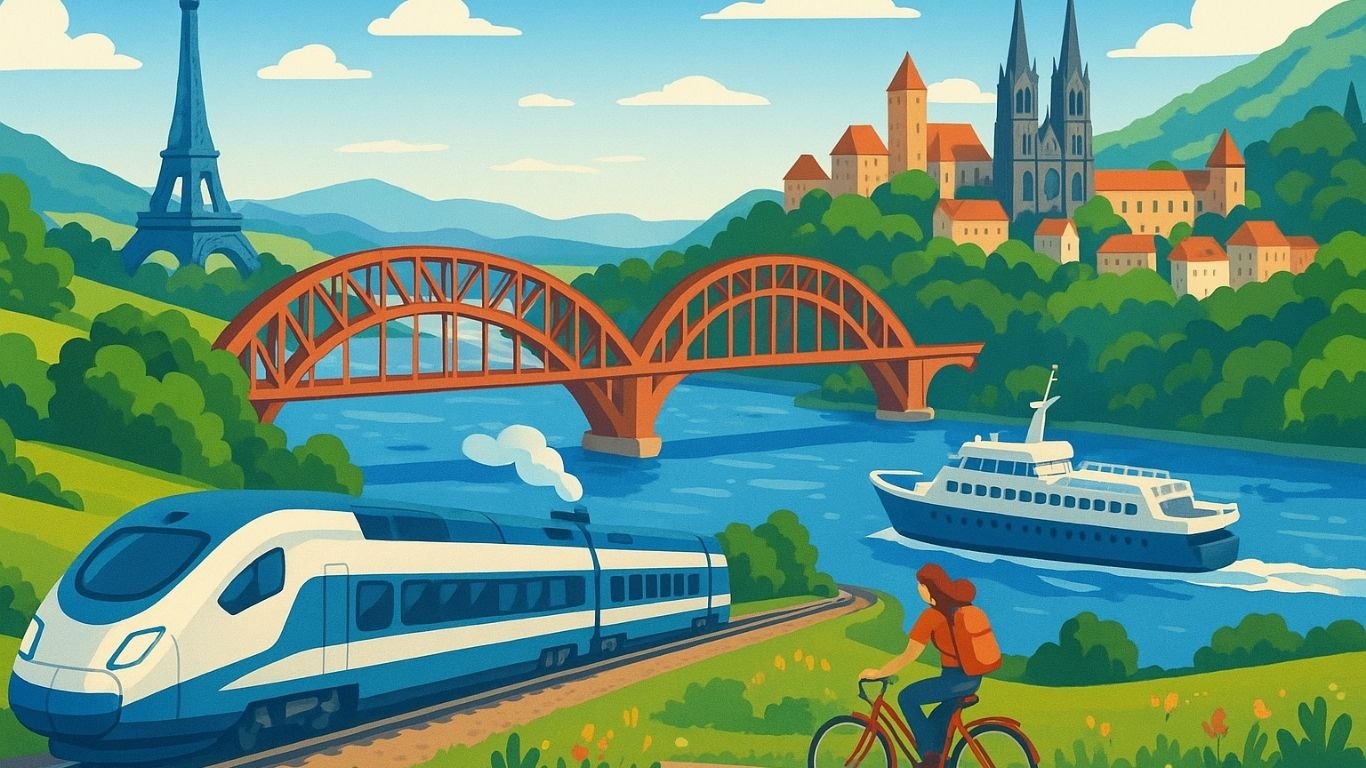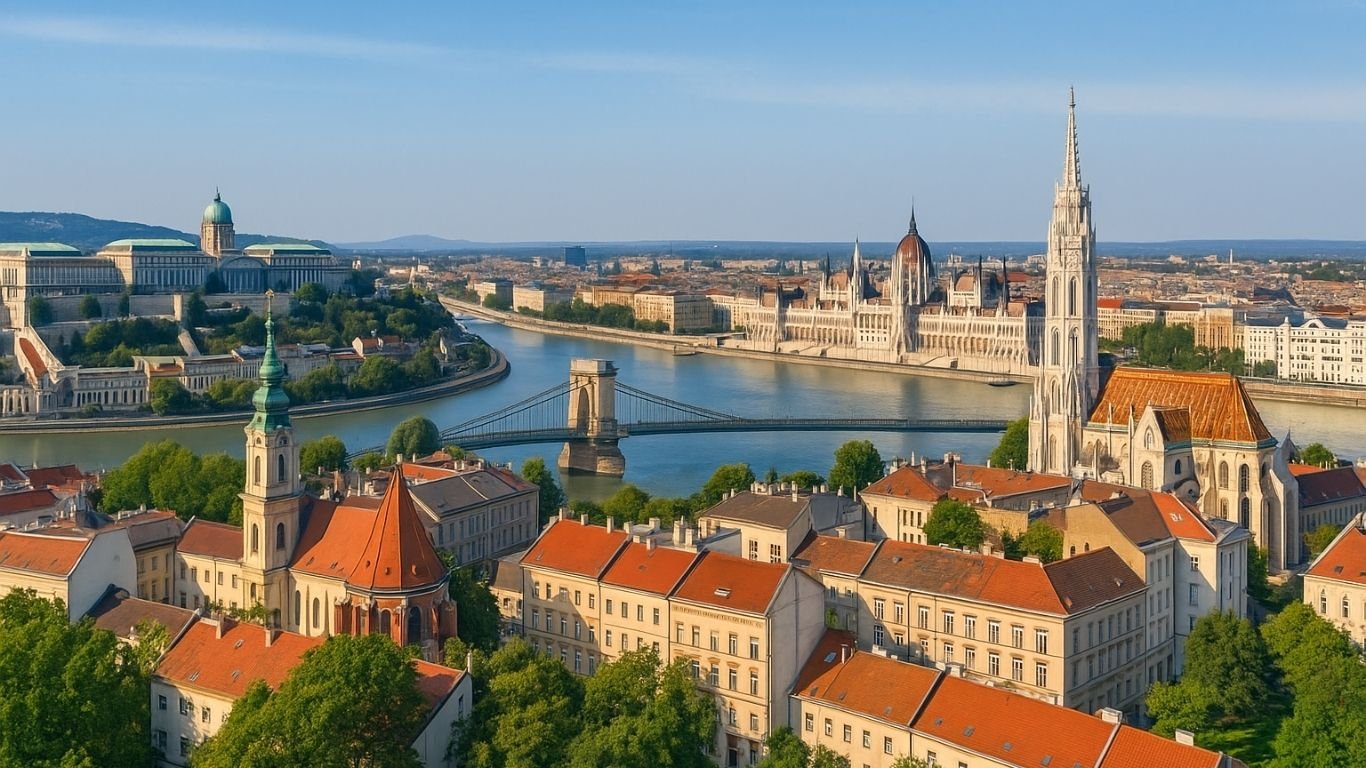To truly see Europe without flying is to experience the continent as it was meant to be discovered—through its landscapes, its people, and its timeless sense of movement. This isn’t just a nostalgic nod to train whistles or ferry horns—it’s a deliberate, modern way of traveling that aligns with sustainability, deeper exploration, and the joy of the journey itself.
Instead of airport lines and flight delays, imagine sipping coffee as vineyards roll past your train window, sailing into Nordic harbors under the midnight sun, or winding along scenic backroads through hilltop villages and forested valleys. Europe offers a rare gift: the ability to travel seamlessly across countries by land and sea, without ever stepping onto a plane.
This guide is your companion to doing exactly that. Whether you’re drawn to the comfort of high-speed trains, the accessibility of long-distance buses, or the charm of ferries and slow travel routes, we’ll show you how to craft a memorable itinerary that lets you see Europe without flying—while traveling smart, sustainably, and in style.
Table of Contents
Train Travel in Europe: A Comprehensive Overview
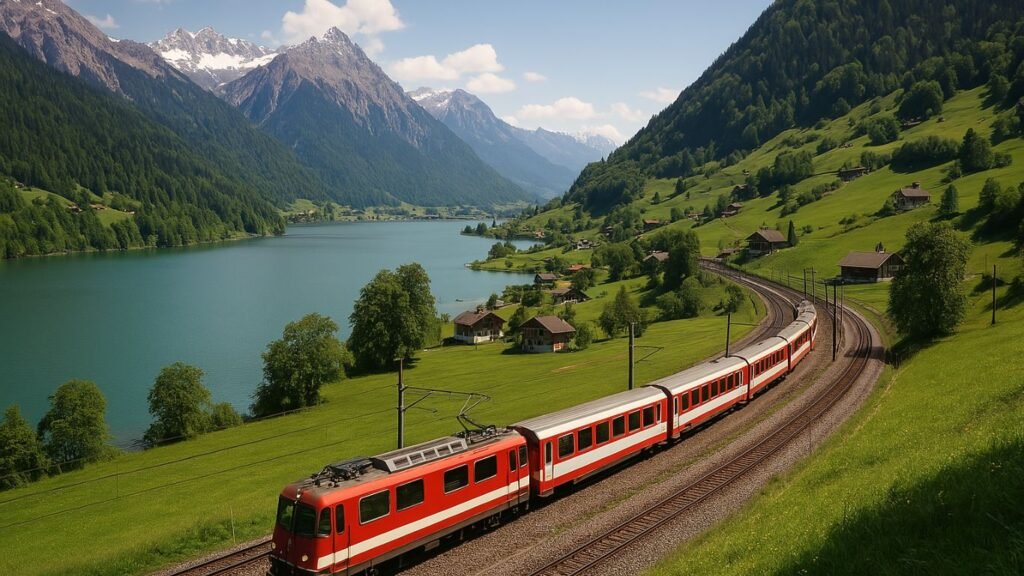
Understanding the European Rail Network
Europe’s rail network is one of the most sophisticated and traveler-friendly systems in the world. Spanning over 200,000 kilometers of track, it connects major capitals, charming villages, and remote alpine outposts with remarkable efficiency. From high-speed marvels like France’s TGV and Germany’s ICE to regional and scenic lines in places like the Balkans or Scandinavia, train travel offers both comfort and flexibility.
One of the most compelling reasons to see Europe without flying is the ability to move between countries seamlessly. The Schengen Agreement plays a crucial role here—once inside the Schengen Zone, most cross-border train journeys are passport-check-free. This means you can hop on a morning train in Amsterdam and sip an espresso by lunch in Milan, all without airport security or long queues.
More than just a mode of transport, European trains often feel like a continuation of the destinations themselves. Italy’s Trenitalia zips you through Renaissance cities, while the Bernina Express takes you through a UNESCO World Heritage landscape, its windows framing lakes, glaciers, and mountain passes like works of art.
Essential Train Passes and Tickets
For travelers looking to explore multiple countries or cities, investing in a train pass can dramatically simplify planning and save money. The Eurail Global Pass (available to non-Europeans) and the Interrail Pass (for European residents) offer unlimited train travel across 33 countries, with flexible durations to match your itinerary. These passes cover high-speed, regional, and some night trains, though reservations are often required for the fastest routes.
Individual tickets are ideal for short distances or single-country travel. Many national rail operators—such as DB (Germany), SNCF (France), ÖBB (Austria), and Renfe (Spain)—offer competitive advance fares online. Booking early often results in significant discounts, especially on high-speed services.
Tip: Websites like Trainline, RailEurope, and Seat61 are invaluable for route planning, comparing fares, and navigating reservations, especially for international journeys.
Popular Scenic Train Routes
Seeing Europe by train isn’t just practical—it’s a visual feast. Here are a few routes that elevate the journey into an experience:
- Bernina Express (Switzerland to Italy): Arguably Europe’s most stunning train ride, this route glides through glaciers, stone viaducts, and alpine meadows, linking Chur and Tirano.
- West Highland Line (Scotland): A dramatic route through the Scottish Highlands, passing lochs, rugged peaks, and the Glenfinnan Viaduct—famous from the Harry Potter films.
- Cinque Terre Line (Italy): This short yet magical stretch along the Ligurian coast connects five colorful seaside villages. Windows open to the sea, cliffs, and vineyards.
- Norway’s Bergen Line: Crosses the Hardangervidda plateau, the highest in Europe, with landscapes that feel otherworldly in both summer and winter.
These journeys are more than mere transfers—they’re stories told through windows, with each bend revealing another breathtaking view.
Tips for Comfortable Train Travel
To truly enjoy your rail experience across Europe, comfort and preparedness go a long way:
- Reserve seats early, especially for popular routes or during holidays.
- Travel light, with a suitcase or backpack that fits overhead or under your seat.
- Pack snacks and water, though many long-distance trains offer food carts or dining cars.
- Use rail apps to track schedules, delays, and platform changes in real time.
- Download maps offline, particularly if you’re changing trains in rural areas where Wi-Fi or mobile signals may be limited.
Train travel gives you the luxury of watching the continent unfold in real time. It’s less about rushing and more about relishing—exactly the spirit behind choosing to see Europe without flying.
Bus Travel: Affordable and Accessible
Major Bus Companies and Networks
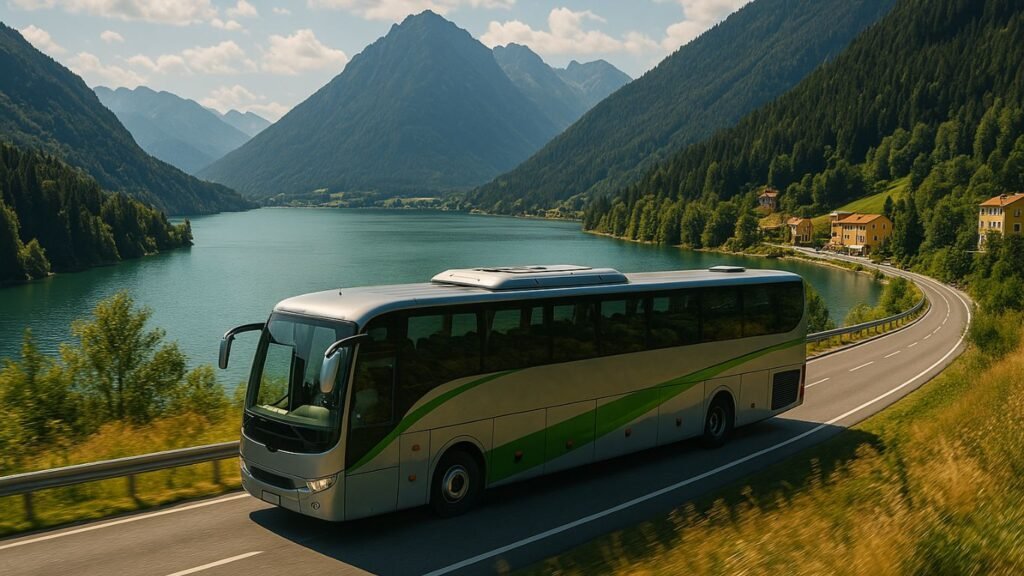
While trains are often the stars of European travel, buses provide a highly underrated way to see Europe without flying—especially for budget-conscious or spontaneous travelers. Europe’s long-distance bus network has expanded rapidly over the past decade, offering extensive coverage, competitive pricing, and increasingly comfortable amenities.
FlixBus, based in Germany, is the dominant player across much of the continent, covering over 2,500 destinations in more than 35 countries. Its routes stretch from the Atlantic coast of Portugal to the Polish-Ukrainian border. Eurolines and RegioJet also operate robust intercity services, especially in Central and Eastern Europe, while ALSA serves much of Spain and Portugal with a reputation for punctuality and comfort.
Most long-distance buses now include onboard Wi-Fi, reclining seats, power outlets, and clean restrooms—offering a more refined experience than the backpacker buses of decades past. In many cases, bus stations are located in city centers, saving you the long commute often associated with airports.
Long-Distance Bus Travel Tips
Though buses tend to be slower than trains, they offer an excellent value and often reach places the rail network doesn’t. To make the most of your journey:
- Book early for the best fares, especially in summer or around major holidays.
- Use aggregator sites like Busbud or Omio to compare routes and companies.
- Choose night buses to save on accommodation and maximize daylight for sightseeing.
- Pack a neck pillow and light blanket for overnight journeys—buses can get chilly.
- Bring snacks and water, as rest stops can be irregular and sometimes brief.
If your goal is to see Europe without flying and spend less doing it, buses are your best allies—especially for routes not well-served by trains or for last-minute plans.
Exploring Off-the-Beaten-Path Destinations by Bus
Buses shine when it comes to reaching smaller towns, national parks, and hidden gems that might be skipped by conventional train routes. Want to hike the Plitvice Lakes in Croatia, discover medieval Český Krumlov in the Czech Republic, or soak in the hot springs of Hungary’s lesser-known towns? Buses often provide the only direct connection.
For the adventurous traveler, this opens up an entirely different side of Europe—one where you can see the continent not just through famous capitals, but through quiet villages and winding mountain roads. Traveling this way forces you to slow down and notice the details: the roadside cafés, the landscapes rolling by, the lives unfolding at each stop.
In short, buses don’t just bridge the gaps—they invite you to redefine your map of Europe.
Scenic Alternatives: Beyond Trains and Buses
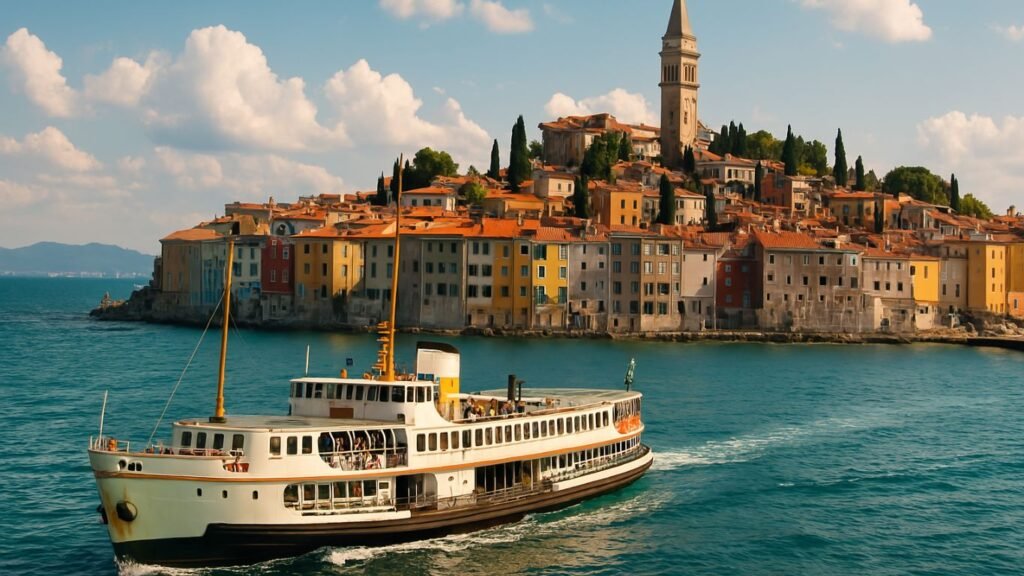
Ferries and Cruises: Coastal Adventures
One of the most atmospheric ways to see Europe without flying is by water. Ferries and coastal cruises aren’t just functional—they’re part of the journey itself. Europe’s coastlines are crisscrossed by centuries-old maritime routes, many of which are still in operation today.
In Northern Europe, ferries are essential links. You can sail from Stockholm to Helsinki, Tallinn to Riga, or Kiel to Oslo, often overnight on modern ships with cabins, dining, and entertainment onboard. These routes are not just practical—they offer unique views of archipelagos, fjords, and the midnight sun in summer months.
In Southern Europe, ferries connect dozens of islands to mainland hubs: think Athens to Santorini, Naples to Palermo, or Barcelona to Ibiza. These voyages reveal an entirely different rhythm of travel—slower, saltier, and rich with history. Some routes allow for island-hopping, turning transportation into a leisure activity in its own right.
Meanwhile, mini-cruises along the Adriatic Coast (especially in Croatia and Montenegro) or Baltic Sea combine multiple countries or islands in one voyage, offering a compact, elegant way to experience the continent’s waterscapes.
Cycling and Hiking: Slow Travel Experiences
For those who want to truly immerse themselves in local culture and scenery, cycling and hiking offer unmatched depth. These are not just alternatives to flying—they’re philosophies of movement.
Europe has embraced slow travel with gusto. EuroVelo, a network of long-distance cycling routes, spans over 90,000 kilometers across the continent. You can cycle along the Danube River from Germany to Romania, traverse the Atlantic Coast Route through France and Portugal, or ride through wine country in the Loire Valley.
Hiking routes are equally storied. The Camino de Santiago in Spain draws thousands of pilgrims annually, while the Alpe-Adria Trail connects Austria to Slovenia and Italy through some of Europe’s most jaw-dropping alpine scenery. For coastal beauty, the Cinque Terre trails or Portugal’s Rota Vicentina offer endless sea views and rustic charm.
These journeys require more effort but reward travelers with a profound connection to the land and its people. They’re especially suited for those who value time over speed and stories over schedules.
River Cruises and Canal Boats: Inland Waterways
Europe’s rivers were once the continent’s superhighways—and many still are. River cruises, particularly on the Rhine, Danube, Seine, and Douro, offer a luxurious, unhurried way to glide between cities, castles, vineyards, and historical landmarks.
Unlike ocean cruises, river journeys are intimate. Boats are smaller, ports are often in the heart of towns, and the scenery rarely disappears over the horizon. You might dock in Vienna in the morning, drift past Melk Abbey by noon, and enjoy a wine tasting in Wachau Valley by evening—all without changing seats.
For something even slower, canal boating in France, the Netherlands, or England allows travelers to rent self-navigated boats and pilot their way through centuries-old waterways. It’s the epitome of leisurely travel—mooring where you like, cooking aboard, and waving at cyclists from your floating perch.
Planning Your Ground Travel Itinerary
Budgeting for Ground Travel
Seeing Europe without flying doesn’t just align with sustainable values—it can also be remarkably cost-effective when planned well. While trains can be pricey if booked last-minute, early-bird deals and passes often rival or undercut flight prices. Buses, ferries, and slow-travel options like cycling can dramatically stretch your budget while enriching your experience.
Start with a clear travel budget and divide it into categories: transportation, accommodation, food, activities, and contingencies. Use tools like Rome2Rio, Omio, or Google Maps Transit to compare route options and costs across modes. Night buses or trains can double as a night’s stay, offering two-for-one value. For longer journeys, factor in the value of scenery and comfort—spending €15 more on a train with panoramic views may well be worth it.
Packing Essentials for Ground Journeys
Ground travel requires strategic packing—mobility is key. Since you’ll be boarding buses, switching train platforms, and possibly hiking or cycling, opt for a lightweight backpack or rolling suitcase that fits overhead compartments.
Essentials include:
- Travel pillow, eye mask, and earplugs for overnight journeys
- Compact toiletries and wet wipes for freshening up en route
- Snacks and reusable water bottle—particularly helpful during long transfers
- Offline maps and translation apps for remote stops or border crossings
- Power bank and universal adapter to stay charged on the move
Weather across Europe can shift quickly—layered clothing and a good waterproof jacket are always wise.
Booking and Reservation Strategies
The key to seamless flight-free travel is proactive booking, especially for high-demand routes and popular seasons.
For trains:
- Book through national rail sites or Trainline at least 1–3 months ahead.
- Reserve seats on high-speed lines, especially TGV, Eurostar, or AVE.
For buses:
- Use aggregator platforms like Busbud, FlixBus, or Omio.
- Look for flexible tickets or options to change dates at no extra cost.
For ferries and cruises:
- Book popular routes (e.g. Greek islands in summer) well in advance.
- Check baggage policies—some ferry companies have airline-like restrictions.
It’s also smart to build in buffer time between connections, especially when switching transport modes. Delays can happen, and missing a train because of a late ferry isn’t an experience anyone enjoys.
Dealing with Delays and Disruptions
Ground travel can be wonderfully liberating, but it’s not immune to hiccups. Weather, strikes, or mechanical issues may affect your journey—especially in countries with aging infrastructure or extreme winters.
Here’s how to stay prepared:
- Download rail or bus apps that update in real-time (e.g. DB Navigator, ÖBB, SNCF Connect).
- Travel with a flexible mindset—sometimes a missed train becomes an opportunity to explore a new town.
- Carry travel insurance that includes coverage for delays or cancellations.
- Keep essential items in your daypack: phone charger, documents, meds, snacks, and cash (some rural areas are still card-averse).
A grounded traveler doesn’t panic—they pivot. And often, those detours lead to the most memorable moments.
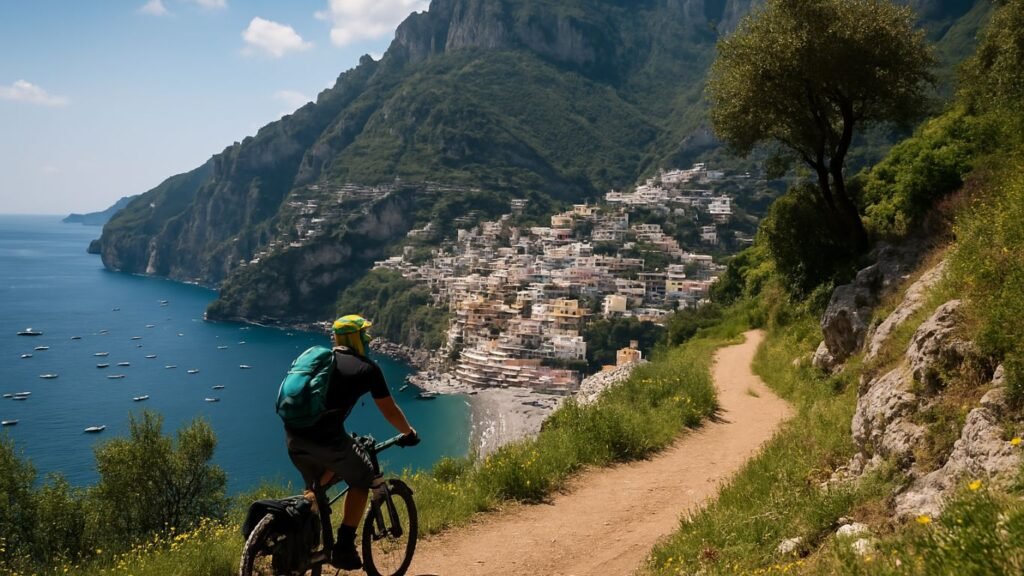
Sustainable Travel: Reducing Your Carbon Footprint
The Environmental Impact of Flying vs. Ground Travel
When we talk about why it’s worth choosing to see Europe without flying, environmental impact stands front and center. Aviation is responsible for approximately 2.5% of global CO₂ emissions, but its effects are amplified due to emissions at high altitudes. According to the European Environment Agency, one short-haul flight emits up to 20 times more CO₂ per kilometer per passenger than a train journey on the same route.
By contrast, trains—especially electric ones—have a much smaller environmental footprint. Many of Europe’s rail systems, such as those in Switzerland, France, and the Netherlands, run on renewable electricity. Buses, while less efficient than trains, still outperform planes in emissions per passenger-kilometer. Ferries, too, are increasingly adopting greener technologies, from hybrid engines to cleaner fuel alternatives.
The takeaway is simple: skipping flights is one of the most impactful choices a traveler can make. It’s not just about how you get there—but how your journey shapes the world you’re exploring.
Tips for Eco-Friendly Ground Travel
It’s not enough to avoid planes—how you travel by land also matters. Here’s how to lighten your footprint while embracing the journey:
- Choose direct routes: The fewer transfers, the lower the cumulative emissions.
- Travel light: Every extra kilo increases fuel consumption—less is greener.
- Opt for regional or slower trains where possible—they use less energy.
- Pack a reusable kit: Water bottle, utensils, cloth shopping bag, and food container.
- Use public transport, bike-sharing, or walk instead of rideshares or taxis in cities.
Even small acts compound over the course of a trip. Think of your choices as votes for the kind of travel industry—and planet—you want to support.
Supporting Sustainable Tourism Initiatives
Flight-free travel goes hand in hand with responsible tourism. When you slow down and engage more deeply with the places you visit, you become part of a more equitable and sustainable travel model.
Look for ways to support local economies and conservation efforts:
- Stay in locally owned accommodations like guesthouses, family-run inns, or eco-lodges.
- Shop from local artisans rather than mass-produced souvenir stands.
- Visit protected areas and pay conservation fees where applicable—your entry helps fund preservation.
- Choose certified eco-tourism operators, especially for tours involving nature, wildlife, or indigenous cultures.
Websites like Green Pearls, Ecobnb, or BookDifferent can help you find sustainable options across Europe. And always remember—respect for culture and environment goes further when you travel slowly, intentionally, and with open eyes.
Practical Resources and Tools
Useful Websites and Apps
Planning to see Europe without flying becomes much easier with the right digital tools. Whether you’re booking trains, tracking buses, or navigating ferries, a few websites and apps can turn logistical headaches into smooth sailing.
- Trainline – Book trains and buses across 45 European countries. Clean interface, flexible filters.
- Rome2Rio – See every route between two points, including trains, buses, ferries, and more.
- Omio – A great aggregator for comparing rail, bus, and flight options (useful for weighing impact).
- Rail Europe – Official partner of multiple rail networks, useful for passes and scenic route planning.
- DB Navigator (Germany), SNCF Connect (France), ÖBB (Austria) – Best for national train updates.
- FlixBus & BlaBlaCar Bus – Book low-cost intercity buses across Europe.
- Ferryhopper – Ideal for planning island-hopping routes, especially in Southern Europe.
Offline functionality is essential in remote or underground areas, so be sure to download routes, tickets, and maps in advance.
Travel Communities and Forums
When you choose to see Europe without flying, you’re joining a growing global movement—one that’s passionate, well-informed, and eager to help. Online forums are goldmines of real-time advice, travel inspiration, and route troubleshooting.
- r/solotravel and r/travel (Reddit) – Ideal for asking logistical questions or finding route advice.
- The Man in Seat 61 – A beloved blog with extensive, deeply detailed advice for train and ferry travel.
- Nomadic Matt’s Forum – Community-driven insights for budget and sustainable travel.
- Facebook groups like Europe by Rail, Slow Travel Europe, or Backpacking Europe Without Planes provide helpful peer support and firsthand experiences.
Engaging with these platforms can help you refine your route, find hidden gems, or even meet like-minded travelers en route.
Language and Communication Tips
Ground travel often means crossing multiple countries—and languages—in a matter of days. While English is widely understood in tourist zones, venturing into smaller towns or rural areas can present language challenges.
Here’s how to stay connected:
- Download Google Translate offline packs for the countries you’ll visit.
- Use apps like SayHi or iTranslate Voice for quick, on-the-spot translations.
- Learn a few polite phrases—hello, please, thank you, and “Where is the station?” go a long way.
- Install offline maps (like Maps.me or Google Maps) for navigating unfamiliar cities.
Being able to communicate, even just a little, fosters goodwill—and often unlocks experiences that wouldn’t happen in an airport lounge.
Conclusion: Embracing the Journey
To see Europe without flying is to rediscover the essence of travel. It’s a deliberate, rewarding choice that favors depth over speed, experience over efficiency, and connection over convenience. Trains, buses, ferries, and even bikes and boots unveil a continent shaped by centuries of stories—and invite you to be part of its ongoing narrative.
This kind of travel isn’t about ticking off bucket-list destinations at breakneck speed. It’s about watching the light shift on a French vineyard as your train hums by, sharing snacks with strangers at a bus terminal in Bulgaria, or gliding silently past misty castles on a Rhine riverboat.
It’s about encountering landscapes, not just landing in them.
Choosing to explore Europe without flying does more than shrink your carbon footprint—it expands your perspective. It invites you to travel consciously, sustainably, and with intention. It reminds you that how you get there is just as important as where you’re going.
So, whether you’re mapping out a rail journey from Lisbon to Ljubljana or cycling the coast of Brittany, let the journey lead you—not just to places, but to moments that stay with you long after the miles are behind you.
FAQ
Is it really possible to see Europe without flying?
Yes—Europe has one of the world’s most comprehensive and interconnected ground transport systems. With its high-speed rail lines, extensive bus networks, ferries, and cycling routes, you can travel the continent efficiently and comfortably without boarding a single plane.
Is train travel in Europe more expensive than flying?
It depends on the route and timing. While last-minute train tickets can be pricey, booking in advance or using passes like the Eurail or Interrail can offer significant savings. Plus, consider the added value—no luggage fees, scenic views, and city-center arrivals.
What’s the best resource for planning ground travel routes?
Apps like Rome2Rio, Omio, and Trainline are great for comparing modes and prices. For detailed rail advice, The Man in Seat 61 is unparalleled.
How can I reduce my environmental impact while traveling in Europe?
Opt for trains or buses over flights, travel light, use public transport within cities, support local businesses, and pack reusable items like water bottles and bags.
Are there night trains and buses in Europe?
Yes. Night trains are making a comeback with routes like Vienna to Paris or Berlin to Zürich. Buses also run overnight on major routes and often offer reclining seats, making them a good budget-friendly alternative to hotel stays.
What if I don’t speak the local language?
Basic English is understood in many parts of Europe, especially in transport hubs. However, downloading Google Translate and learning a few key phrases will enhance your experience and help you connect more deeply with locals.
According to the European Environment Agency, transport contributes to about a quarter of the EU’s total greenhouse gas emissions, with road transport accounting for the largest share. Opting for trains and other sustainable travel methods can significantly reduce your carbon footprint.
